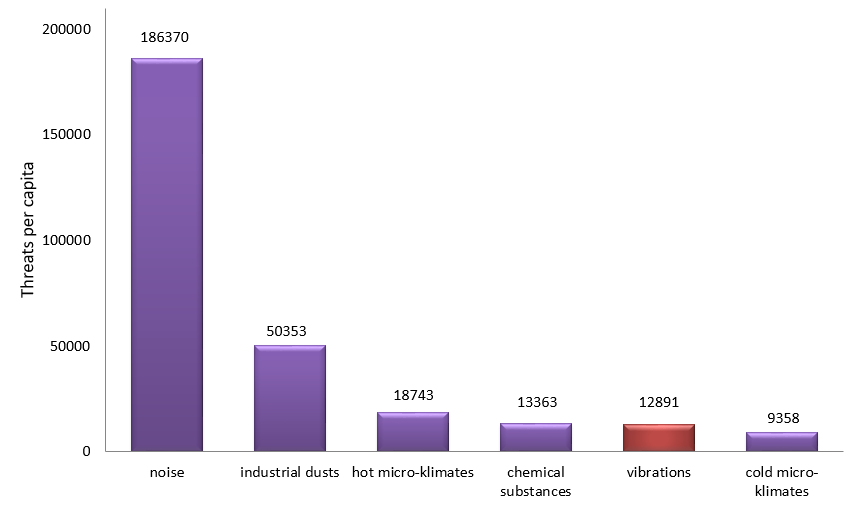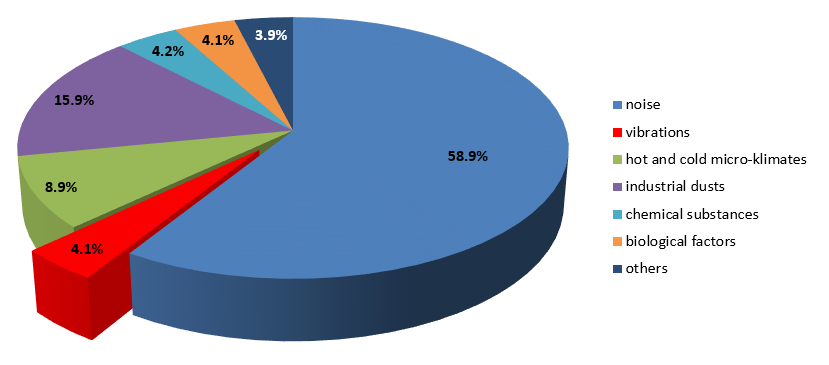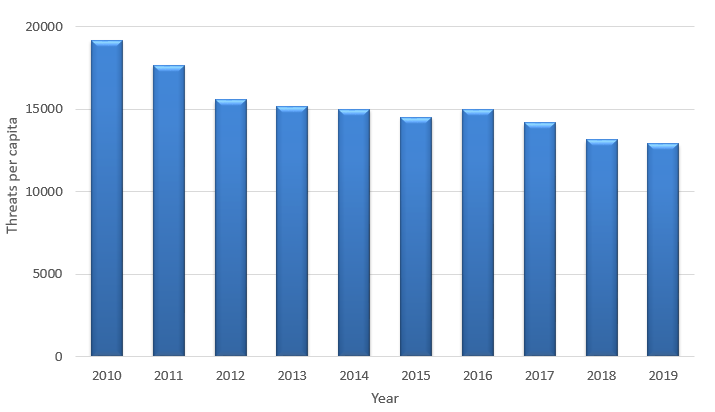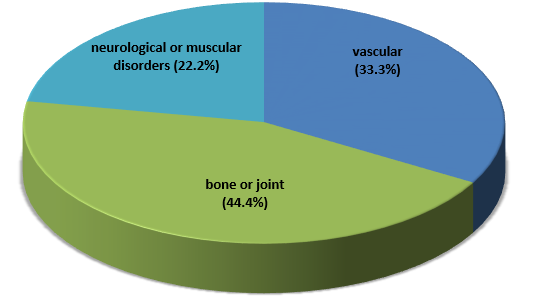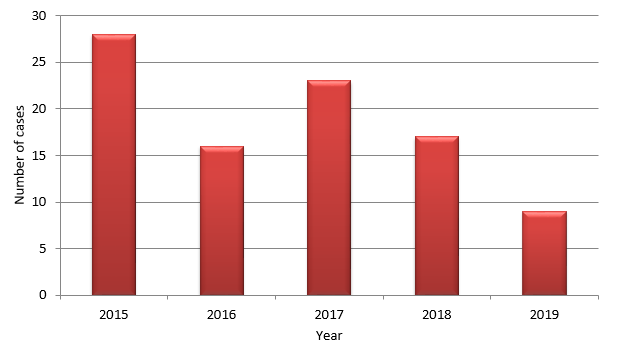Misją Instytutu jest dzialalność naukowo-badawcza prowadząca do nowych rozwiązań technicznych i organizacyjnych użytecznych w kształtowaniu warunków pracy zgodnych z zasadami bezpieczeństwa pracy i ergonomii oraz ustalanie podstaw naukowych do właściwego ukierunkowywania polityki społeczno-ekonomicznej państwa w tym zakresie.

HAZARD OF MECHANICAL VIBRATIONS IN THE WORK ENVIRONMENT IN POLAND
The presented statistical data illustrates the threatening state of mechanical vibrations in the work environment in Poland. These were compiled based on data published by Statistics Poland ("Work conditions in 2019", Warsaw 2020) and Nofer Institute of Occupational Medicine ("Occupational diseases in Poland in 2019", Łódź 2020). The category of the so-called threats per capita, used in descriptions indicate the number of employees situated in hazardous conditions counted as many times as the number of hazards these persons were exposed to. That is for example if the employee is exposed simultaneously to mechanical vibrations, noise and chemical substances, then we are dealing with three threats per capita. Conversely there is only one harmful factor for each employee, then the sum of the threats per capita is equal to the number of people exposed to harmful factors.
The graphs in Figure 1 and Figure 2 illustrate that mechanical vibrations are the fourth harmful factor in the work environment in terms of the number of employees at risk. In 2019, 12.891 workers were exposed to mechanical vibrations. A comparison based on GUS data from 2018 and 2019 shows (refer to Figure 3) that the number of employees threatened with mechanical vibrations remains at a similar level. However a decreasing tendency can be observed in the long run as shown by Figure 4.
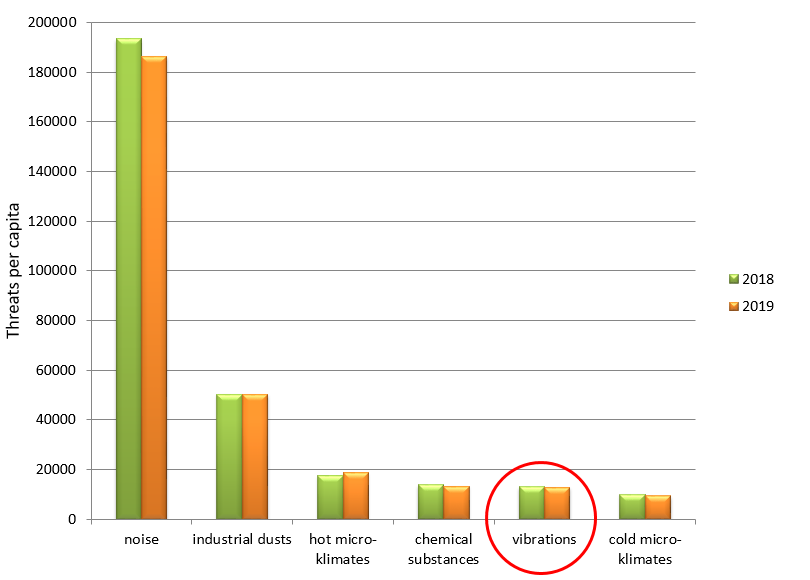
Fig. 3. Employees in conditions of threat of harmful factors and strenuous work in 2018 and 2019.
The graph in Figure 5 depicts the threat from mechanical vibrations in the work environment for individual provinces. The highest number of those endangered by this factor was recorded in 2019 in the following provinces: Silesian (2295 at risk), Lower Silesian (1988) and Greater Poland (1575). There is a direct relationship between the treats per capita for a given province and the amount of industrial processing plants and mining sectors.

Fig. 5. Threat associated with mechanical vibrations by voivodeships in the work environment in 2019.
Statistical data from previous years shows that employees from the following sectors have an increased risk of experiencing vibration hazards at work: industrial processing, construction, transport, storage and mining. Despite the general declining trend, the number of employees in conditions of threat from mechanical vibrations increase in many sectors of the national economy.
THE INFLUENCE OF VIBRATION ON THE HUMAN BODY
Negative effects of vibrations on the human body depends largely on the location at which vibrations penetrate the body. As a result mechanical vibrations have been divided into:
- Hand-arm vibration are directly applied or transmitted to the hand-arm system, commonly through the palm of the hand or through fingers.
- Whole-body vibrations are transmitted to the body as a whole, usually through areas such as buttocks, soles of the feet and back.
Operators making use of pneumatic hand tools, hydraulic, electrical and exhaust are mainly exposed to hand-arm vibrations. These tools are commonly used in many sectors of the economy. The source of exposure may also be control elements of machines and devices operated with hands and hand-held elements being processed during work.
Epidemiological studies have shown a close causal relationship between work environments constituting exposure to hand-arm vibrations and the occurrence of disease related to the vascular, nervous and osteoarticular systems in employees. Such diseases called the vibration syndrome, have been recognized in many countries, including Poland as a occupational disease. The changes in the vasculature are associated with paroxysmal disturbances of blood circulation in the fingers of the hands (temporary cessation of circulation due to the contraction of the peripheral blood vessels). The observed symptom of these disorders is the blanching of the fingers of the hands, hence the vascular form of the vibrational syndrome is commonly called the "finger-white syndrome". At the beginning of the disease, blanching affects the fingertips of one or more fingers. Further exposure to vibrations causes the symptoms to extend to other parts of the fingers. Depending on the severity level of the disease, the pallid attack may last from several minutes to over an hour. During an attack, a person may experience loss of feeling and control of the fingers. In the case of significant disease severity, there may be trophic skin changes in the area of the fingertips. Changes in the nervous system resulting from the effects of hand-arm vibrations are mainly disturbances in the sense of touch, sensation of vibration, temperature, as well as discomfort in the form of numbness or tingling of the fingers and hands. Changes in the osteoarticular system caused by hand-arm vibrations are mainly distorted joints, calcifications of muscle tendons and joint bags, and periosteum changes.
The whole-body vibrations are primarily exposed to drivers and operators of all types of construction, mining, road and agricultural vehicles and machines on which work is carried out in a sitting position. In these work stations, vibrations from the seats are transmitted to the body of the worker through the supporting surfaces (that is buttocks, back and sides etc.). Exposition to whole-body vibrations also applies to employees who operate machines and stationary devices in standing position operated in various work rooms. Then, vibrations penetrate the worker's body through his feet from the vibrating ground on which the workstation is located, and the effects of these vibrations are similar to those of the vibrations transmitted from the seats.
Negative effects of occupational exposure to whole-body vibrations relate in particular to the skeletal system and human internal organs. In the skeletal system, disease changes arise mainly in the lumbar region of the spine. Unfavorable changes in internal organs, occurring as a result of whole-body vibrations, are mainly the result of stimulation of individual organs to resonance vibrations which may lead to the appearance of disturbances in their functions, and even in extreme cases to the mechanical disruption of organs. The most frequently observed disorders concern the functioning of the organs of the digestive system, the vestibular and cochlear organ, the organs of the chest and reproductive organs of women. In addition to the possibility of damage to internal organs, whole-body vibrations can cause a number of other non-specific physiological and psychophysical reactions such as visual acuity disorders, increased motor and visual reaction times, fatigue, and coordination disorders.
OCCUPATIONAL DISEASES
According to According to Regulation of the Council of Ministers of 30 June 2009 on occupational diseases, (Journal of Laws 2009, nr 105, item 869 witch changes Journal of Laws 2012 item. 662) in vibration syndrome is recognized as an occupational disease . The regulation lists three forms of this disease:
− Vascular
− Bone or joint
− Neurological or muscular disorders
Data on occupational diseases in Poland are collected in the Central Register of Occupational Diseases at the Nofer Institute of Occupational Medicine.
The graph from Figure 6 shows the number of cases of each of the forms of the vibration syndrome from 2019.
The diagrams in Fig. 7 and Fig. 8 illustrate the number of occupational disease cases found in Poland throughout 2019 expressed in absolute numbers per 100,000 working people (incidence rate). The presented data was limited to diseases with the highest incidence. The presented data shows that in 2019, there were 9 cases of vibration syndrome, which correspond to a coefficient of incidence equal to 0.1.
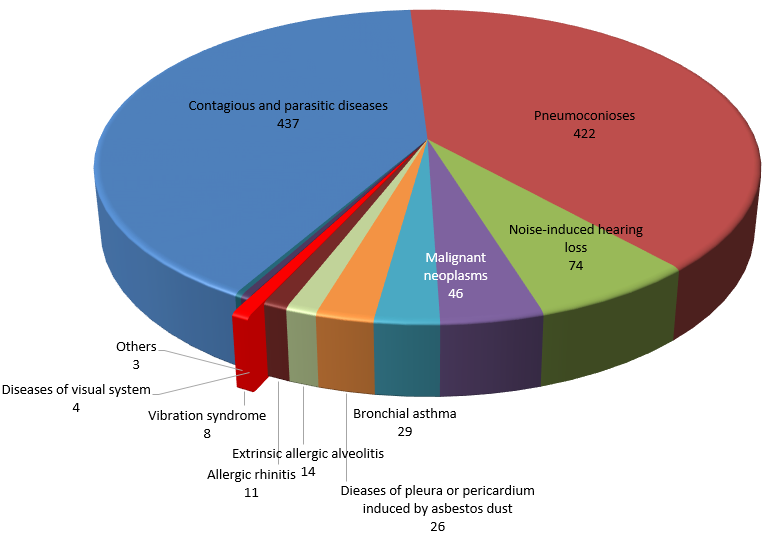
Fig. 7. The dominant occupational disease among men in Poland in 2019 - The number of reported cases.
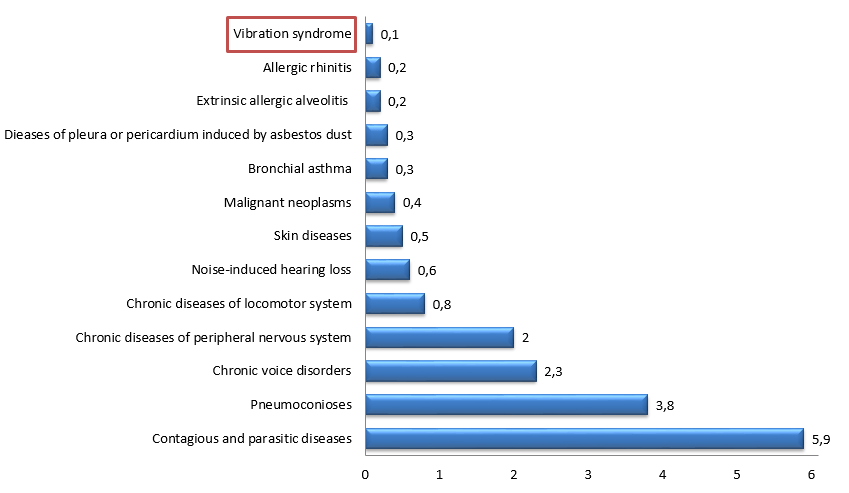
Fig. 8. Dominant occupational diseases in Poland in 2019 - number of cases found per 100.000 employed (incidence rate).
Figure 9 presents data on reported cases of vibration syndrome in 2019 in the sections of the national economy in which the highest risk of mechanical vibration was recorded. Most cases of this disease are found in the sections of agriculture, forestry and fishing (3), manufacturing (3), mining and quarrying (1), and construction (2). These are sections in which various types of pneumatic, hydraulic, electric and internal combustion tools are commonly used, such as pneumatic hammers, drills (including impact drills), grinders, impact beaters and chainsaws.
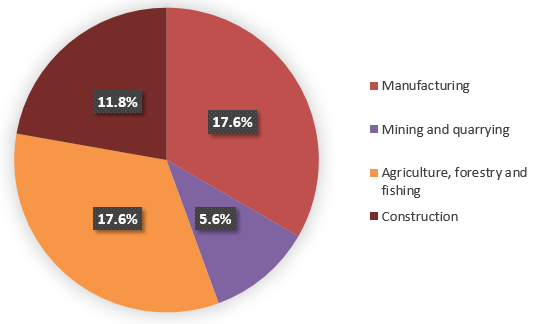
Fig. 9. Representation of vibration syndrome by sections of the national economy in Poland for 2019.
In recent years, the number of new cases recorded in the vibration syndrome has been following a declining trend as depicted in Figure 10.



